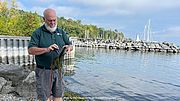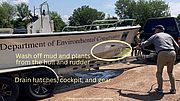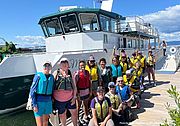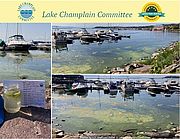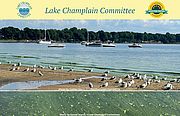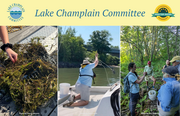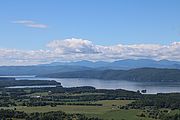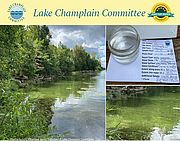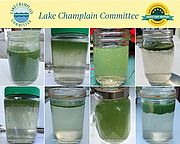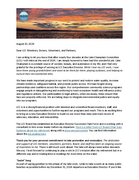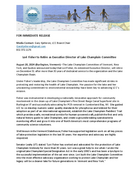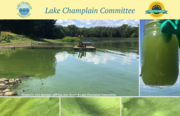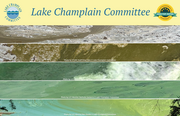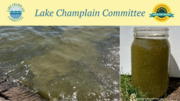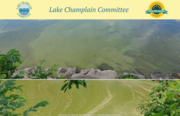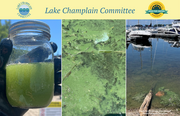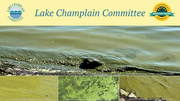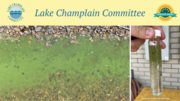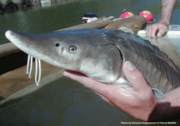Aquatic invasive species (AIS) are among the major challenges facing Lake Champlain—they reduce biodiversity by outcompeting native species and disrupting ecological processes, and they can proliferate to impact water quality and recreation. LCC launched a volunteer community science initiative—the Champlain Aquatic invasive Monitoring Program (CHAMP)—to train folks how to identify and survey for key AIS in Lake Champlain. We still need volunteers to survey before the snow flies—you can sign up on our website and we’ll schedule additional trainings in your area. Read on to learn more about the program and stories from the field. Read...
News from Selected Month
Humans are the main conveyors of most aquatic invasive species, moving them from one body of water to another. Many of these troublesome plants and animals can be unintentionally transported on fishing gear, boating equipment, or even tiny amounts of water left in a watercraft. The simplest and most effective way to prevent the spread of aquatic invasives is to ensure that your vessel and all your equipment are cleaned, drained, and dried.
In June 2024 the Lake Champlain Basin Program -- the entity that coordinates and helps fund implementation of the Lake Champlain restoration and management plan in partnership with New York, Vermont, and Quebec government agencies – released its 2024 State of the Lake Report. The 36-page document provides an update on how Lake Champlain is faring according to four goals of clean water, healthy ecosystems, informed and involved public, and thriving communities. It includes a “scorecard” showing data trends on phosphorus, cyanobacteria blooms, and the introduction of new invasive species and uses easy-to-understand graphics and maps to illustrate complex issues. Read on for a brief tour of the contents and some take-aways. Read...
The Lake Champlain basin is full of stories that educators can use to teach all subjects, engage students in learning about their community, and integrate content, service, and a sense of belonging to their home watershed. To delve into these stories with teachers, the Lake Champlain Committee and our partners in the Champlain Basin Education Initiative (CBEI) hosted a course called Watershed for Every Classroom (WEC). The place-based educational program in the Lake Champlain watershed is part professional development and part summer camp for teachers. Read...
Cyanobacteria naturally occurs in lakes and have existed on earth for millions of years. Under the right conditions they form large accumulations referred to as blooms. Some types produce toxins which release into the water especially when cyanobacteria die and break down. Not all cyanobacteria blooms are toxic, but since there is no way to tell if toxins are present without laboratory tests, it is always safest to avoid blooms and adhere to beach closures—when in doubt, stay out. Read...
Blooms were observed daily during week 14 of monitoring and dominated the reports received on 9/15 and 9/20/24. A third of the reports over the seven-day period were of blooms reinforcing the importance of monitoring through much of fall and checking water conditions carefully before recreating. Read...
Hot weather at the end of week 13 helped fuel more blooms on Lake Champlain and inland waterways. When reviewing the stats for this week keep in mind that we have fewer monitors reporting this time of year, so coverage is less comprehensive. Case in point, we only received one report from St. Albans Bay but there were likely more blooms in that area during the week. Read...
Lake Champlain currently has 51 known non-native and invasive species with many more approaching—the Hudson River has over twice as many and the Great Lakes host nearly four times more. AIS pose a significant threat to ecosystem health. Early detection is key to controlling new populations before they become established—and you can help by becoming an LCC CHAMP community science volunteer! Click to learn more and sign up.
After CLF, LCC and VNRC’s petition, EPA says state of Vermont must revamp agricultural regulation. Read...
In a letter issued today to the VT Agency of Natural Resources the US Environmental Protection Agency (EPA) says Vermont falls short on Clean Water Act enforcement. The letter comes almost two and a half years after LCC, the Conservation Law Foundation (CLF), and the Vermont Natural Resources Council filed a petition asking EPA to thoroughly investigate how the state applies the Clean Water Act on farms. The issue arose from the Vermont’s Agency of Natural Resources and Agency of Agriculture both overseeing clean water regulations for farms. EPA found that Vermont does not do enough to regulate concentrated animal feeding operations – farms that keep a large number of animals confined to a small, densely populated space. Read...
Reporting dropped off dramatically during week 12 as we had fewer blooms, and many municipal and state personnel who monitor beaches left seasonal posts. Reminder that while week 12 had a fairly low incidence of blooms compared to recent weeks it is still peak bloom season and cyanobacteria can show up in any waterway. (We are seeing a bloom response to the warmer temperatures in week 13.) Read...
Blooms were dominant at the beginning of week 11 in the northeast section of Lake Champlain on 8/26 with extensive ones reported in Missisquoi Bay, St. Albans Bay, Main Lake North, and the Inland Sea. Blooms were also observed at Lake Carmi, Lake Memphremagog, Shelburne Pond, and Ticklenaked Pond and unusual pink cyanobacteria was observed at Silver Lake in Barnard VT. Read...
Week 10 was busy for the LCC cyanobacteria monitoring team as Lori announced her upcoming retirement (12/31/24), Alexa got married, Lindsey headed off to trek for a week in the wilds of Montana and Alberta, and Eileen wrapped up a big project on native aquatic plants. On the cyanobacteria beat, blooms dominated the scene in some Quebec portions of Lake Champlain’s Missisquoi Bay and parts of St. Albans Bay. Read...
I am writing to let you know that after nearly four decades at the Lake Champlain Committee (LCC) I will retire at the end of 2024. I am deeply honored to have had this wonderful job. Lake Champlain is a constant source of wonder, beauty, and sustenance in my life, and I feel very grateful for the privilege of serving as LCC Executive Director. While I love my LCC work, I now have three young grandchildren and want to be there for them, playing outdoors, and helping to nurture their environmental ethic. Read...
I am writing to share some bittersweet news about the Lake Champlain Committee. After an extraordinary career spanning nearly four decades, our beloved Executive Director, Lori Fisher, has announced her retirement, effective at the end of 2024.
Lori’s unwavering dedication and passion for protecting and preserving Lake Champlain have made her an iconic figure in our community and beyond. Her leadership has been instrumental in countless achievements for the LCC, and her impact on the health and well-being of our lake is immeasurable. We are deeply grateful for her tireless efforts and invaluable contributions to our organization. Read...
The Lake Champlain Committee of Vermont, New York, and Quebec announced today that Lori Fisher, its esteemed Executive Director, will retire on December 31 after more than 30 years of dedicated service to the organization and the Lake Champlain Basin.
Under Fisher’s leadership, the Lake Champlain Committee has made significant strides in protecting and restoring the health of Lake Champlain. Her passion for the lake and her unwavering commitment to environmental stewardship have been key to advancing LCC’s mission. Read...
It was another week of highly variable conditions depending upon where you were. Monitors filed 240 reports during week 9 and 19% were of blooms. The majority came from northern sections of Lake Champlain. Some blooms persisted for days and continued into week 10. The many bloom reports also delayed the compilation and sending of our weekly email. LCC does roughly 90% of the report vetting and follow-up with monitors so our report to you goes out later during high traffic weeks. Read...
Some extensive and persistent blooms were experienced in northern sections of Lake Champlain and various inland waterways including the Poultney River during week 8 of monitoring. Big thanks to all the community science volunteers who are chronicling conditions. Cyanobacteria monitoring will continue through the fall so click here if you’d like to join the 2024 cyanobacteria monitoring team.
Read...While most monitors reported generally safe conditions during their week 7 site rounds, those that did observe blooms often found them widespread. And blooms certainly weren’t restricted to Lake Champlain – VT inland waterways of Lake Carmi, Shadow Lake, and the Moore Reservoir all had significant blooms. In this email you’ll find details on weekly conditions, resources to help you recognize cyanobacteria, along with photographs of Gloeotrichia sp.; spinach smoothie look-alikes; bloom gloom at Lake Champlain sites at Venise-en-Québec QC, Philipsburg QC, Macomber Point in the Inland Sea VT, Niquette Bay VT; and inland lake VT sites at Lake Carmi, Shadow Lake, and Shelburne Pond. Read...
While many monitors reported bloom-free conditions during week 6, where cyanobacteria did show up it sometimes persisted for several days. In this email you’ll find details on weekly conditions; resources to help you recognize, avoid and report cyanobacteria; and photographs of week 6 bloom zooms, high alerts at Stephenson’s Point VT and Philipsburg QC, a low alert at Lake Carmi, khaki-colored blooms, clumps of blooms, Gloeotrichia sp. – a colonial cyanobacteria, tools of the trade, clear water scenes, and parting shots tracking a bloom. Read...
Monitors weathered another week of IT challenges as the tech issue that shut systems down worldwide also affected the cyanobacteria tracker. It’s the reason you’re getting this weekly compilation of results much later than usual. Many LCC monitors had to delay filing reports due to the IT problem so there was a backlog of assessments to enter and vet once the tracker was working again. Read...
It was eerily familiar last week as floodwaters wreaked havoc on infrastructure, communities, and ecosystems, exactly a year after the historic July 2023 flooding. We hope you didn’t personally endure damage but know everyone in the watershed is affected as we witness the devastating effects of another high intensity storm. Some monitors were unable to access their sites due to washed out roads and some sites are closed due to damage. Read...
Hot weather during the 4th of July holiday led to a burst of blooms and the cyanobacteria tracker went down over the weekend making for a challenging week! Please read on for June 30 – July 6, 2024 monitoring results and resources to help you recognize, avoid and report cyanobacteria. Read...
With summer in full swing, the native aquatic plants in Lake Champlain are spreading and blooming, adding pops of color to the water. How did they get here, and what helps make them successful away from land? Read...
Happy summer! Thank you for signing up to receive the Lake Champlain Committee (LCC) Cyanobacteria monitoring reports! Each week we’ll send you an update about conditions monitors are finding on Lake Champlain and at select inland Vermont lakes. Monitoring began the week of June 16 and will run through early fall. This week’s report covers results from Sunday, June 23 through Saturday, June 29, 2024. Read...
Thank you for signing up to receive the Lake Champlain Committee (LCC) Cyanobacteria monitoring reports! Monitoring began the week of June 16 and will run through early fall. Each week we’ll send you an update about conditions monitors are finding on Lake Champlain and at select inland Vermont lakes. This week’s report covers results from Sunday, June 16 through Saturday, June 22, 2024. Read...
Lake Champlain is abuzz this time of year. Aquatic plants leaf out and spread, insects dance along the water’s surface, and people flock to the beaches. All this activity brings to light not only the many things we love about the lake, but also the challenges we face in maintaining its water quality and ecological integrity: it’s the season of cyanobacteria blooms and invasive species spread. With that, it’s the “on-season” for LCC's on-the-water stewardship programs. Read...
The lake sturgeon is a fish with a lot of superlatives. It’s as long as the standing height of an adult man, with longer recorded lifespans than humans. It has been on earth since before the evolution of flowering plants. And it has a complicated relationship with people as it was nearly driven to extinction and is currently designated as endangered in Vermont and threatened in New York. Read...
Do you live near a stream? Is there a healthy vegetated buffer around the stream that runs through your property? If you answered yes, you might be Stream Wise!
Stream Wise awards and recognizes private landowners that maintain wide buffers of native plants along river and stream shoreland to promote water quality and stream resiliency. Maintaining a healthy vegetated buffer around streams helps reduce the amount of runoff that enters our waterways, which is important for water quality. These buffers are also key wildlife habitat.
Fill out our sign-up form and LCC will reach out to schedule an assessment. Read...
On Monday April 8, 2024 the skies above Lake Champlain will go dark in the middle of the afternoon. Almost all of the lake is in the path of totality for the solar eclipse of 2024 passing through Mexico, the US, and Canada. It’s a historic occurrence—on average, any given location sees a total solar eclipse every 355 years. The LCC team is excited to experience this rare celestial event and will be heading out on foot to various viewing locations in the Lake Champlain watershed. Read on for information and resources about what a solar eclipse is, where to go, where not to go, Leave No Trace principles, a solar eclipse sundial, safety, community science opportunities, regional guides, and more to help you experience this once-in-a-lifetime phenomena. Read...

